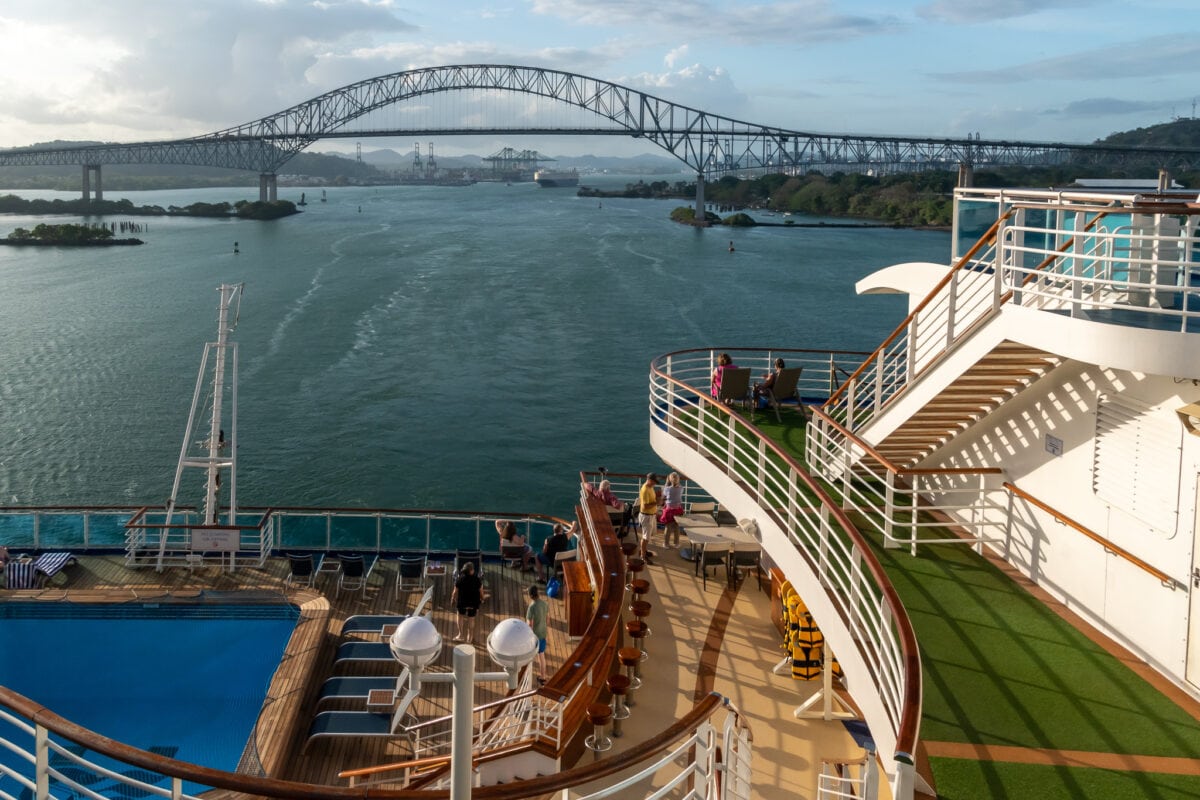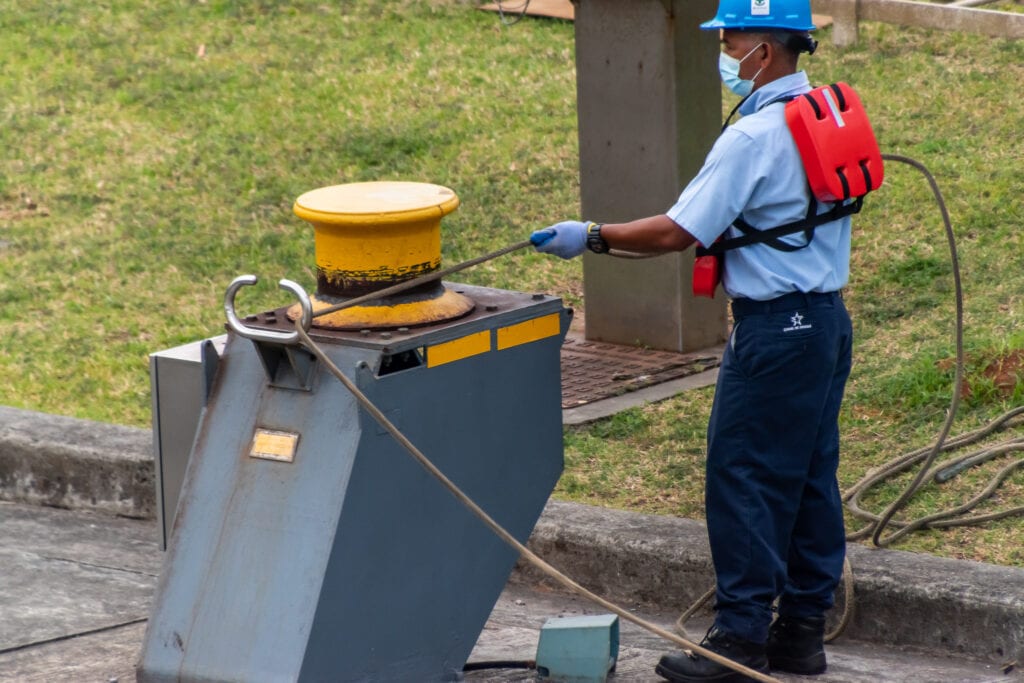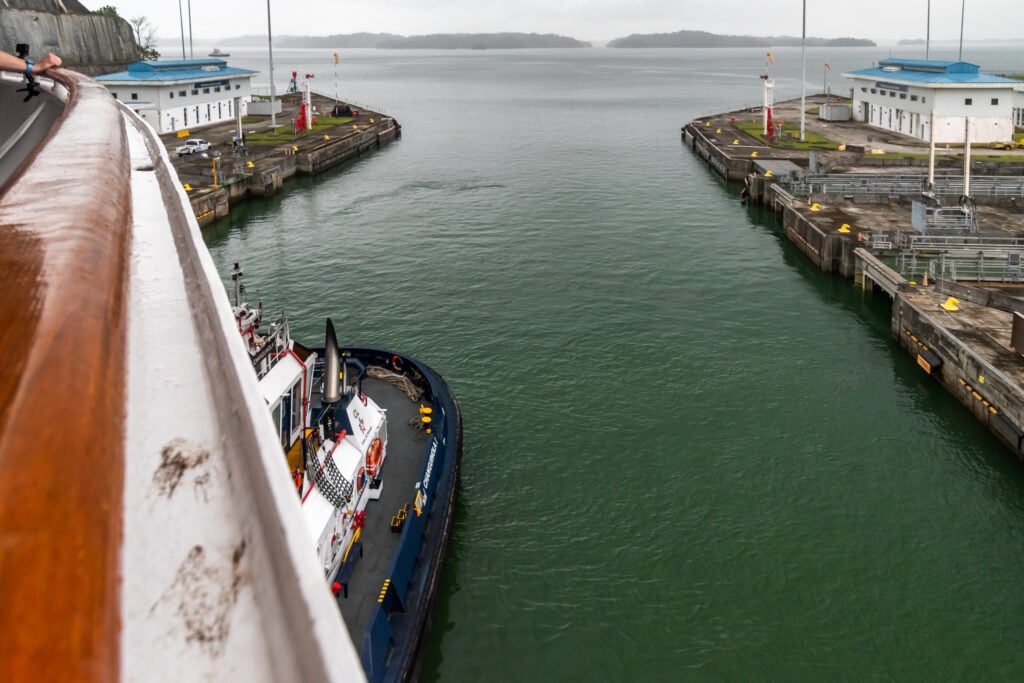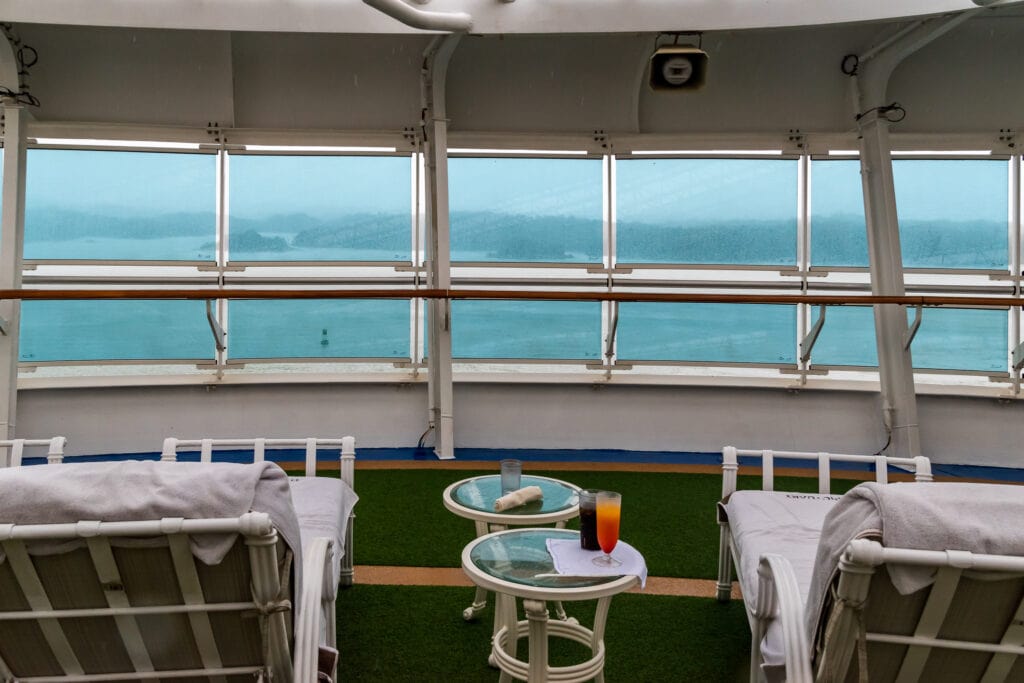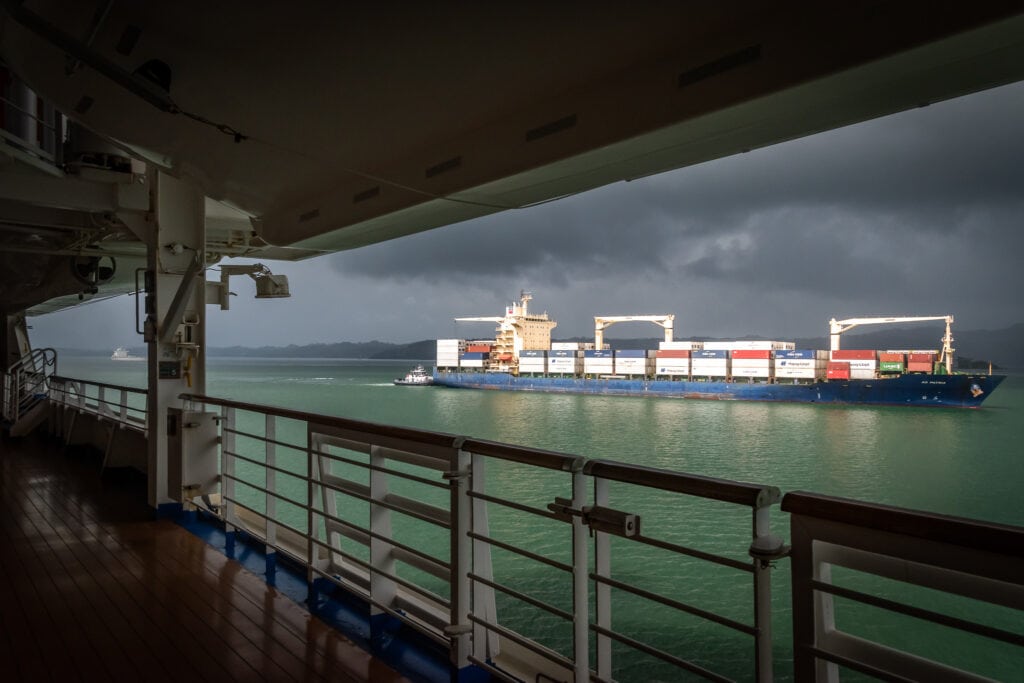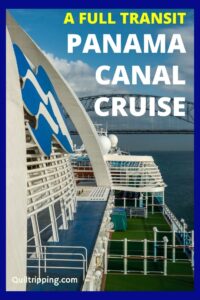Last Updated on 11/18/23 by Rose Palmer
There are some places on this planet that are easiest to experience from the deck of a ship – the Panama Canal is one of those sights. This “Engineering Marvel” was built to aid in the faster transport of goods between the Atlantic and Pacific Oceans, thus bypassing the long and hazardous journey around South America and Cape Horn.
But transiting through the Panama Canal has also become a very popular cruise ship destination. I recently took a 16 day full transit Panama Canal cruise from Fort Lauderdale to San Francisco on the Ruby Princess and going through the canal was the highlight of my cruise.
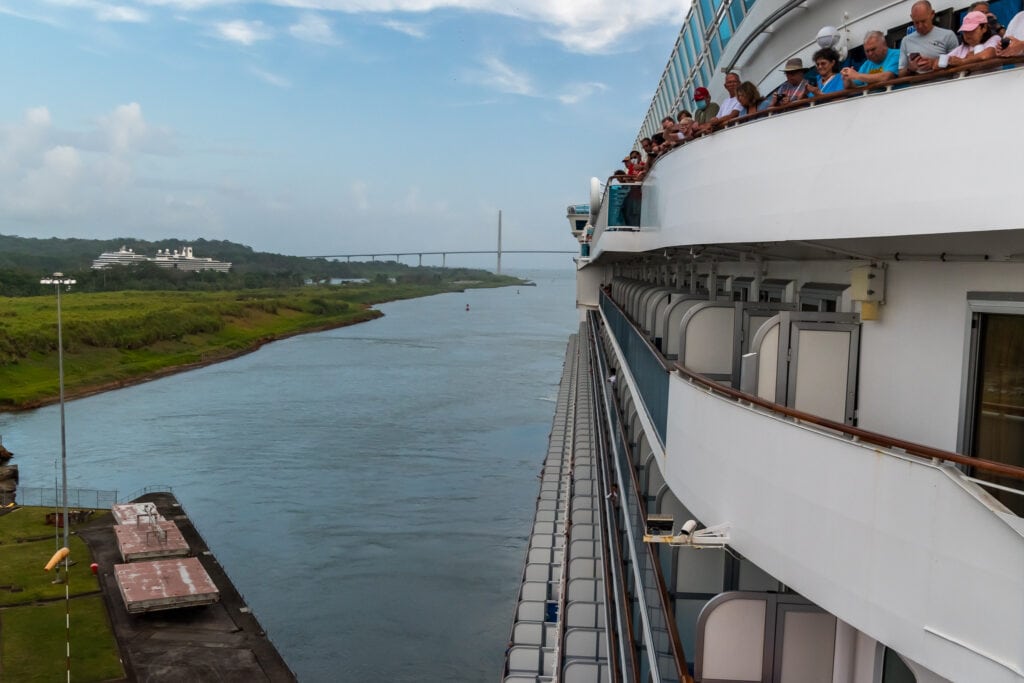
How to see the Panama Canal
Basically, there were four ways I could see the Panama Canal as a tourist:
1 – Take a full transit cruise through the Panama Canal on a cruise ship. As this implies, a full transit takes you through all of the canal and its locks from the Atlantic to the Pacific, or vice versa.
With a full transit cruise your trip starts in one port and ends in a different port. This means you will need two different one way airline tickets: one to get to the port of embarkation and another one from the port of disembarkation to get home after the cruise. This can add to the expense of the trip.
Also, a Panama Canal full transit usually takes two weeks or longer.
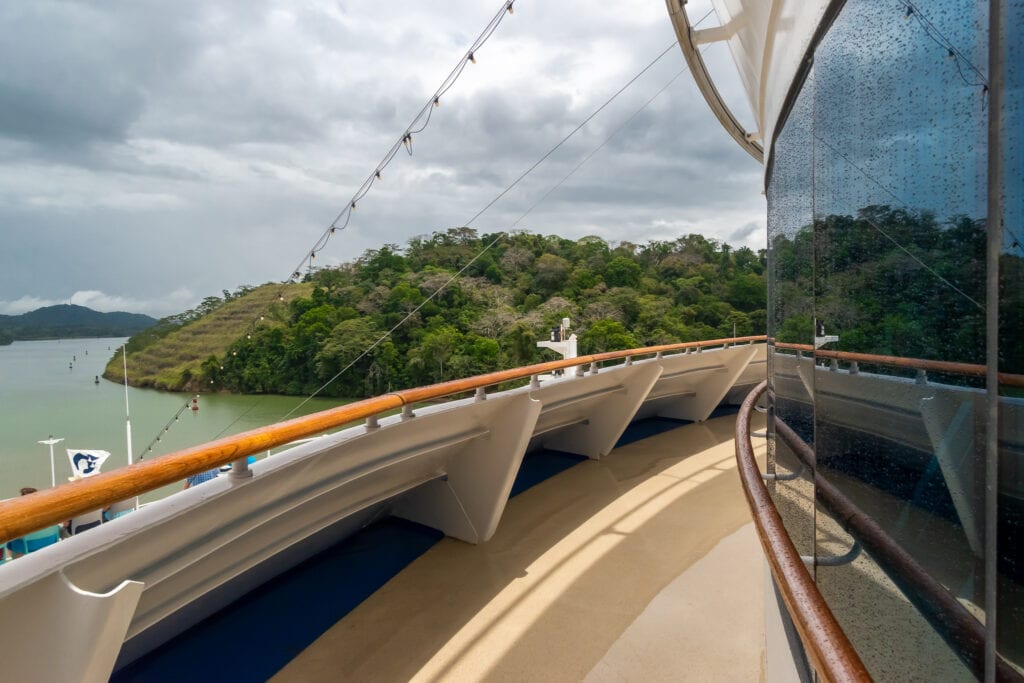
2 – Take a partial transit cruise through the Panama Canal on a cruise ship. A partial transit takes you through one set of locks to Gatun Lake and then takes you back through the same locks so that your starting and ending ports for your cruise are the same.
The advantage of this is that your cruise starts and ends at the same port so you can get round trip airline tickets which may be less expensive than two one way tickets from different cities.
In addition, partial transit cruises are typically shorter trips which often fit better in many people’s vacation schedules. There are many partial transit cruise choices that leave and return from Fort Lauderdale or Miami in the US. I like to use VacationsToGo.com to easily find various cruise options.
3 – Book a day trip into the Panama Canal from Colon or Panama City. If you are visiting Panama, there are many day trip tours on day boats going into the Panama Canal. You can use a website like Viator.com to find a tour that fits your needs.
4 – Sail through the canal on your own – if you have your own boat. This is obviously not an easy or viable option for most of us, but it is possible.
As I planed my Panama Canal cruise, I also needed to decide if I wanted to cruise through the original canal and locks built in 1914 or through the newer canal and locks that were completed in 2016. I had to look at the specific cruise details to determine the size of the ship and which canal the ship planed to sail through.
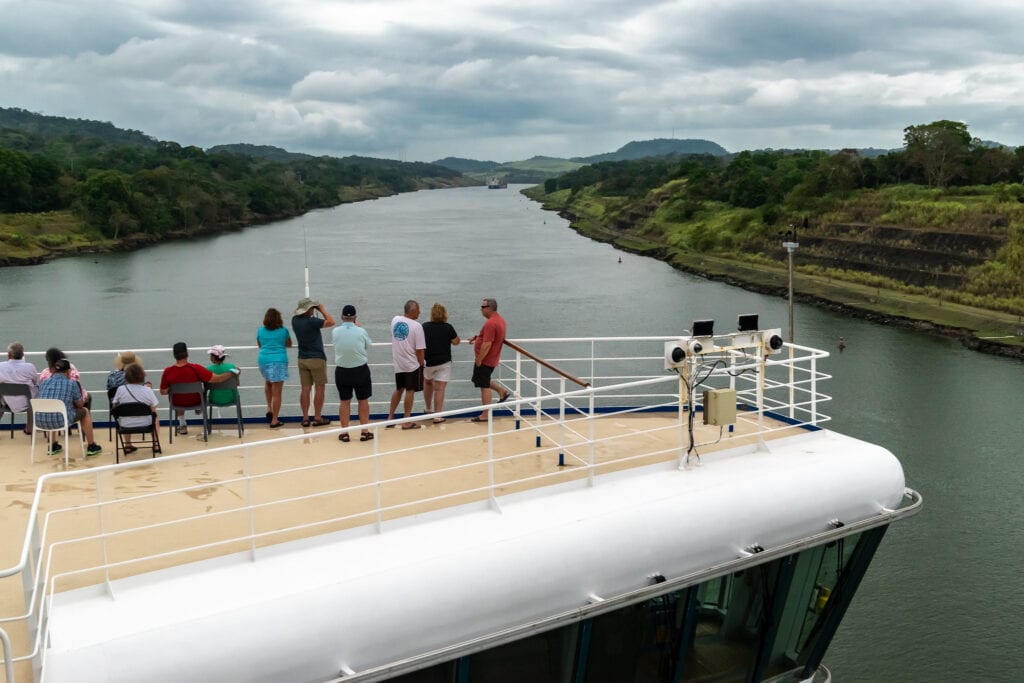
The original canal and locks limited the size of the ship to what is now considered to be smaller cruise ships and are called PanAmax ships. The new Panama canal and channel can handle bigger vessels which are identified as Neo Panamax ships.
Brief Panama Canal History
The French began an attempt to build a sea level canal connecting the Atlantic to the Pacific in 1882, similar to the one they built in Suez. This attempt failed due to various geological, climate, political, and economic challenges.
In 1904 the US restarted a new Panama Canal building project that included the construction of the Gatun Locks on the Atlantic side, on the Miraflores and Pedro Miguel Locks on the Pacific side, and a dam on the Chagres River which formed Gatun Lake, the connecting waterway between the two sets of locks. Gatun Lake also acts as the water reservoir for the lock system, ensuring there is sufficient water to operate the locks even in the dry season.
The Panama Canal was finally completed in 1914. The locks raise a boat 85 feet to the level of Gatun Lake, and then lower the boat 85 feet back to sea level. The original canal and locks are a dual channel design which allows ships to move through it in both directions at the same time.

100 years after its completion, it became evident that the Panama Canal needed to be expanded to allow for the ever increasing cargo traffic and also to handle larger container and cruise ships.
The New Panama Canal Project
The New Panama Canal project was started September 3, 2007 and was finished June 26, 2016. The intent of the project was to make a new transit path that could accommodate the need for larger cargo vessels and cruise ships.
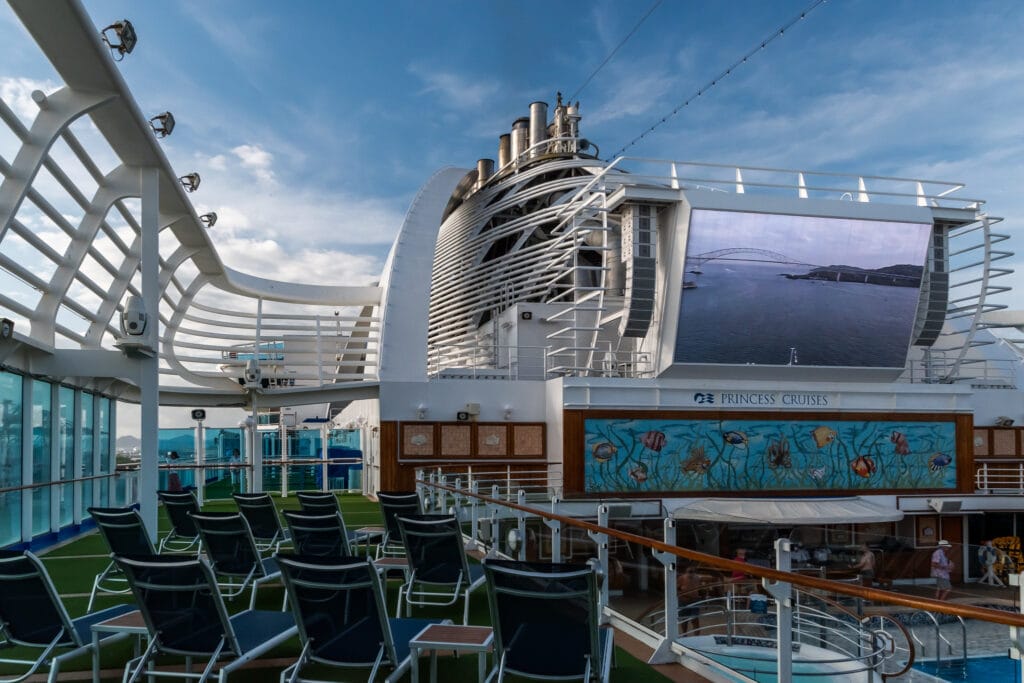
The Ruby Princess was too large for the original Panama Canal locks, so my cruise went through the new canal and locks. A guest lecturer on board provided a lot of information about the new Panama Canal before we crossed through it, and I am sharing all that I learned here.
The scope of the new canal project was quite ambitious: add the New Atlantic Bridge over the canal at Colon city; build the new Aqua Clara Atlantic bypass locks; widen, straighten and deepen the Gatun Lake Channel; widen, deepen, and straighten “the cut”; and build the new Cocli Pacific bypass locks.
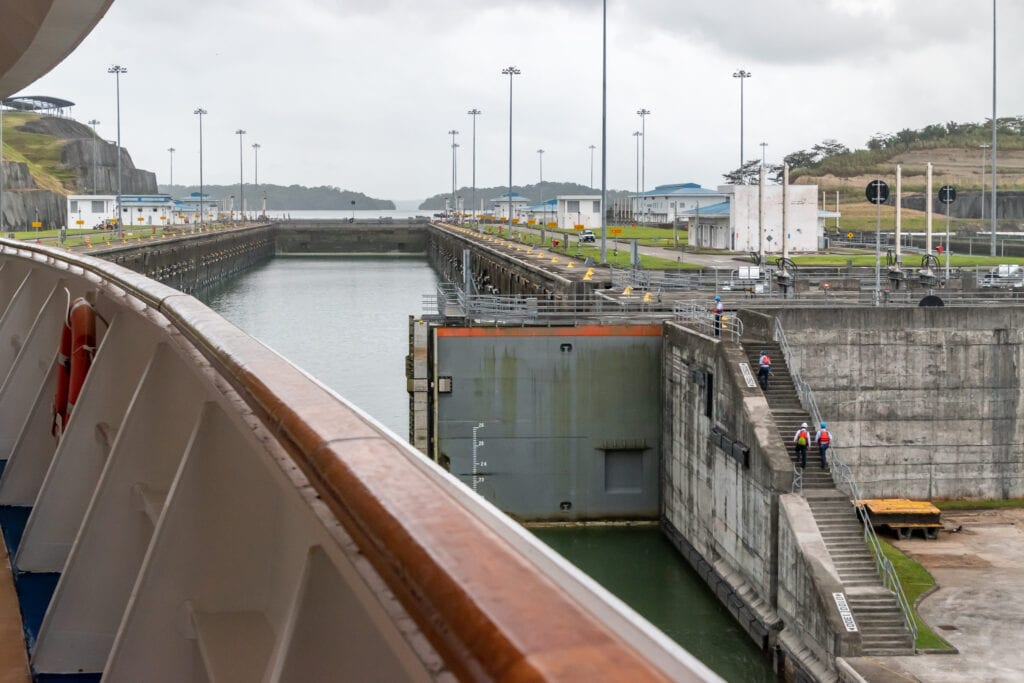
The new canal and lock system also meant more water would be required for Gatun Lake. As a result, the gates on the Gatun Dam Spillway that controlled the flow of the Chagres River also had to be modified. This raised the lake water level by about 1.3 feet and the additional daily lake reservoir capacity increased by about 165 million cubic meters. The water level could not be raised any higher because it would have flooded out the old canal locks.
In addition, the Pacific approach channel needed to be dredged to make it larger which removed 1.4 million cubic yards of spoil. In Gatun Lake, the channel in the lake was deepened to 55 feet, the straight sections were widened to 600 feet, and the curves widened to 1200 feet to accommodate larger vessels. Downstream, the cut, which is made of basalt, was also widened by blasting.
Even more impressive was the fact that all this work was done without stopping regular traffic through the existing Panama canal.

When it was completed, the total cost of the new canal project was around $5.3 billion. To put that into perspective, the canal generates about $3 billion a year in revenue. I would say that is a pretty good return on investment.
The original locks in the “old” Panama canal have dual chambers, one for each direction of ship traffic. In contrast, the new locks have only one chamber so ships travel southbound in the morning (from the Atlantic to the Pacific) and northbound in the afternoon (from the Pacific to the Atlantic).
The new locks are also 60% wider and 40% longer than the first locks. So while the original locks are 110 feet wide and 1000 feet long, the new canal can support a maximum vessel width of 168 feet and a length of 1200 feet with a draft of 50 feet.
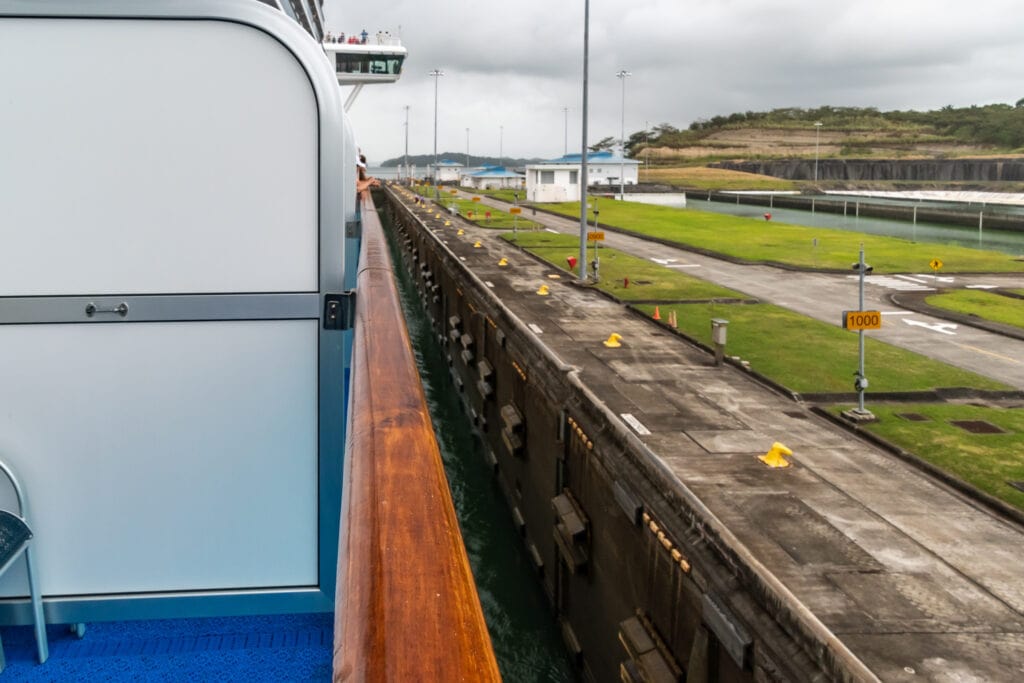
There are also two sets of lock gates which can be used to adjust the chamber length to 1200 feet, 1400 feet or 1600 feet depending on the length of ship. This in turn also provides a water savings.
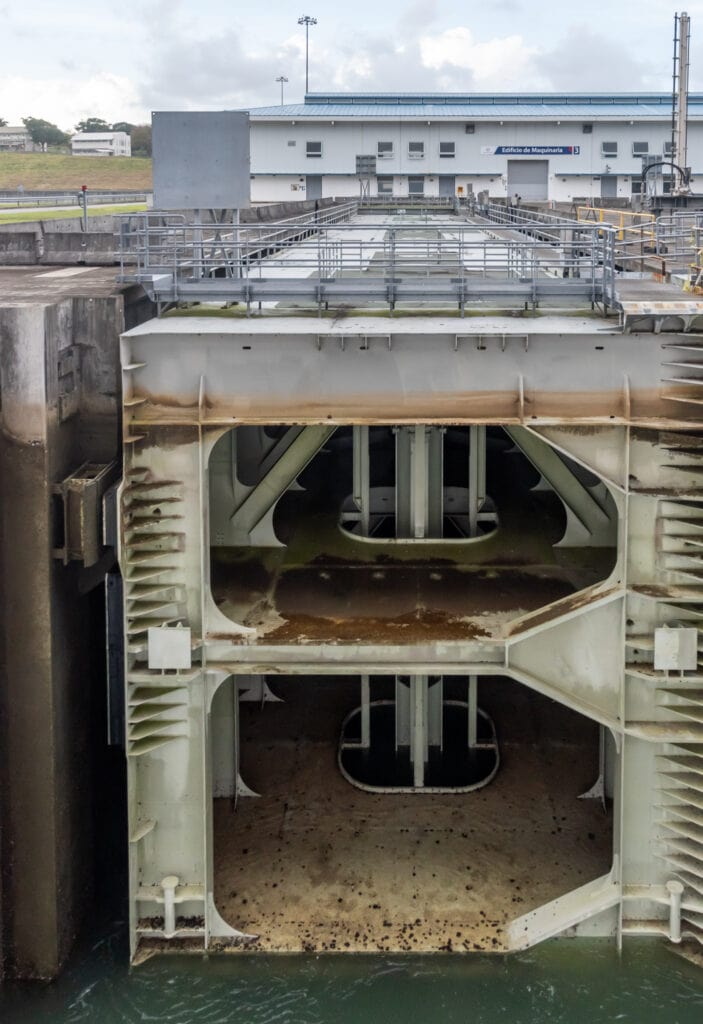
Adjacent to the new locks are a series of large water saving basins. The basins are the size of 14 football fields each and hold 33 million gallons of water (or about 50 Olympic sized pools). Each transit requires 48.36 million gallons of water. The water moves back and forth between the lock chambers and the basins each time a ship is moved.
The basins help the new locks to recycle about 60% of that water and use 7% less water than the old locks and all this is done via gravity and without pumping. Using the water savings basins, it takes on average about 17 minutes to fill a lock.
My full transit Panama Canal cruise experience
After our first port stop at Cartagena, the Ruby Princess cruised on through the night and we reached the city of Colon on the Atlantic side of the Panama Canal early the next day.
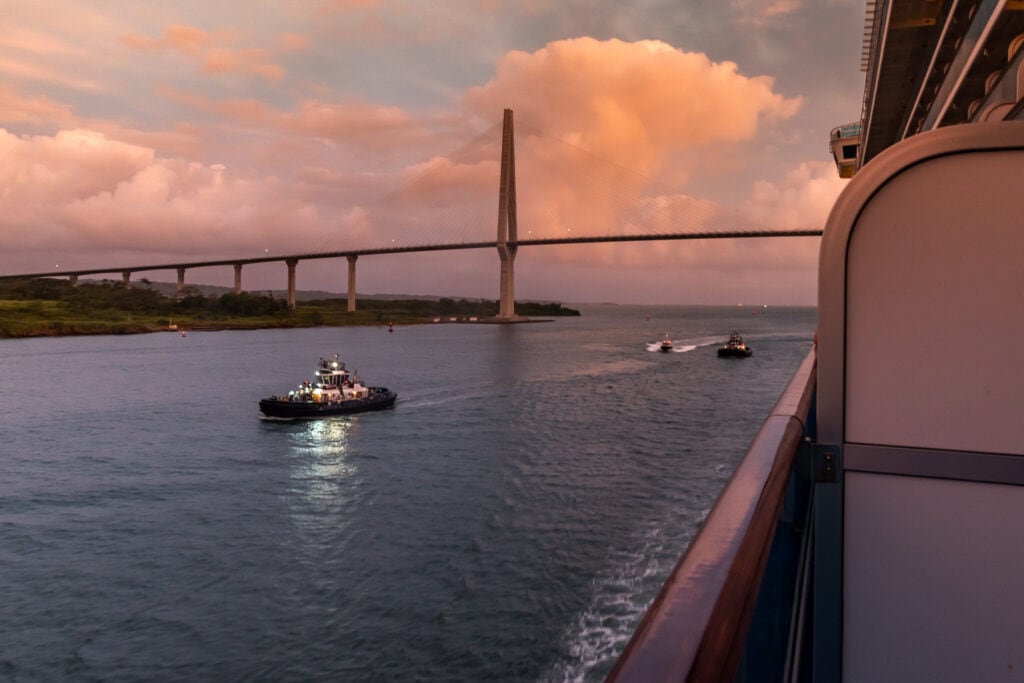
Our transit would take us under the New Atlantic Bridge at Colon, the Agua Clara locks on the Caribbean Sea, then on to Gatun Lake, through “the cut”, under the Centenario Bridge, through the Cocoli Locks on the Pacific Ocean and under the Bridge of the Americas before anchoring at Fuerte Amador outside of Panama City.
My long awaited Panama Canal transit started before the sun was up. The first flush of dawn was just turning the sky pink when launches sidled up to our cruise ship. These small boats were dropping off the pilots and the line crew.

Local lock crews go on board each ship to help take it through the canal. Two pilots came onto our ship early in the morning and stayed all day to direct the passage through the canal, but our ship’s crew still did the “driving”.
A line crew from the Panama Canal Authority also came on board to help with the tie off lines. They threw a messenger line to the crew on land who then tied the messenger line to a heavy ship line and pulled it tight with an electric winch. This helped keep the ship from shifting while inside the lock.
Once all the lock crews were in place, tugs then helped to steer the ship toward the first lock. Two tugs stayed with our ship as it passed through each lock, one in front and one in back.

The stern tug was doing the steering and the breaking while the forward tug was pulling the large ship into place. Tugs need to steer the ship because when such a large ship cruises so slowly the rudder is ineffective and as a result, the ship has no control.
By about 7 AM the Ruby Princess was entering the first Atlantic Ocean lock chamber at Agua Clara. I made my way to the front of the ship for the best views. The crew had opened up the deck area above the bridge which was fondly called “monkey island”.

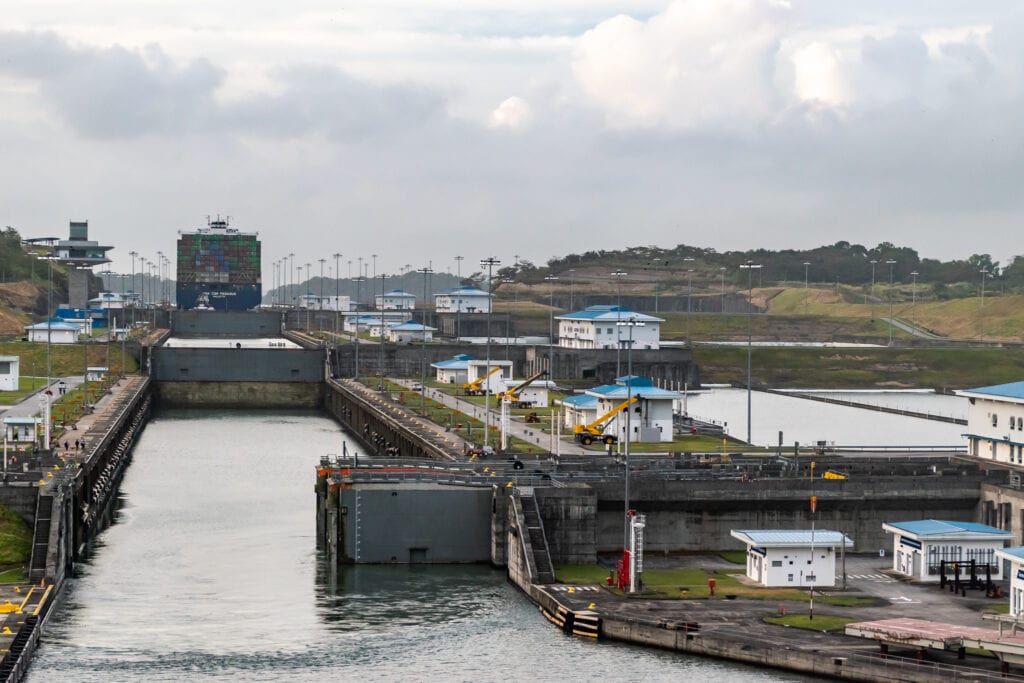


It only took about five minutes for the lock gate to slide into position behind us. Then the chamber started filling with water. At first it did not look like anything was happening, but before long I could tell that the water level was slowly rising. The bumpers on the walls of the lock chamber were slowly getting covered with water. (The bumpers in the locks help protect the ships from damage).


Once the water level in our lock chamber was the same as the water level in the second chamber ahead of us, the lock gates in front of us slowly opened and the tugs then pulled/pushed us into the second chamber. And the whole process was repeated again. And then again as we traveled through the third lock chamber.
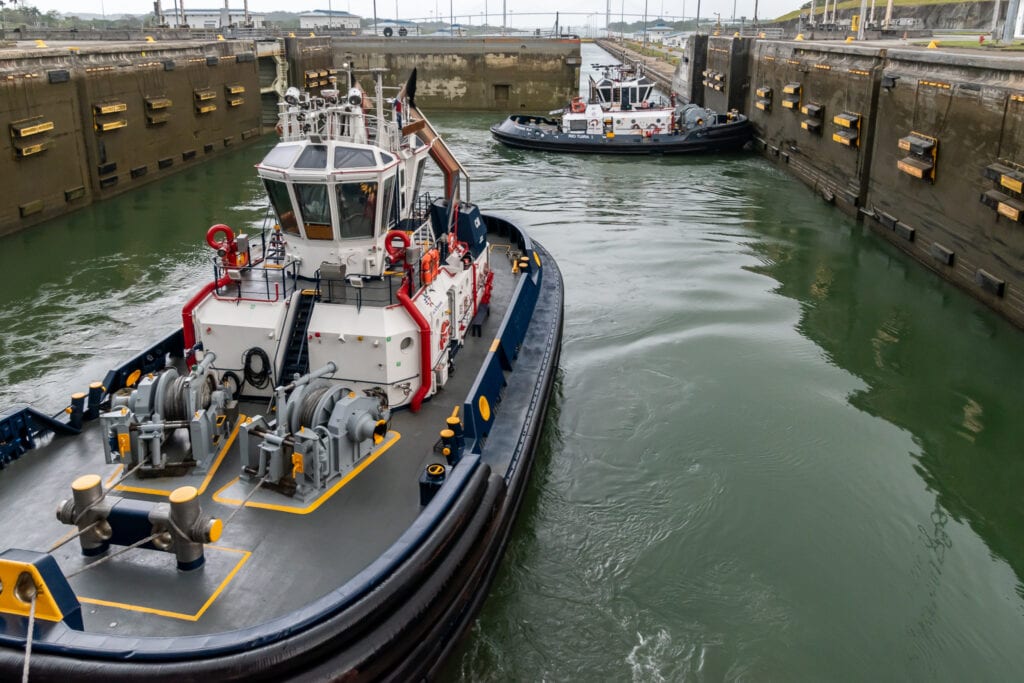
An interesting optical illusion made it look like the locks ahead of us were narrower, even though this was not possible.
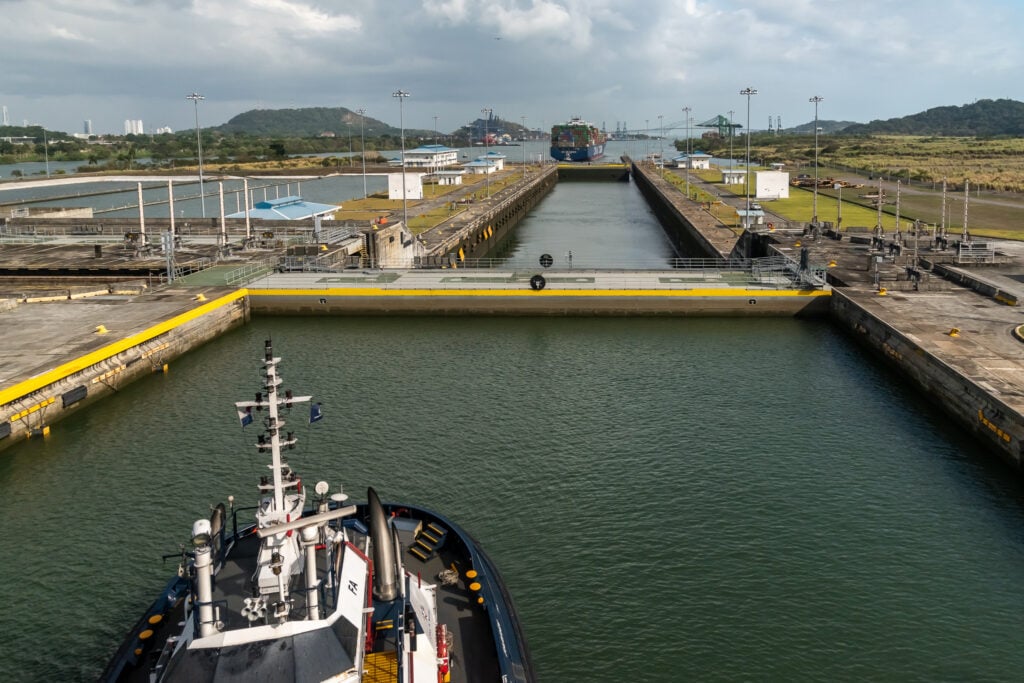
It took about 2.5 hours to fully transit through all three locks. I spent that time going back and forth from front to back and up and down the ship to get different perspectives (and photos).
Once we sailed into Gatun Lake, our two tugboat escorts left us to go and guide another ship. We also said goodbye to the 4 man ground crew that had been escorting us on land and tying us up in each lock chamber.

As we were sailing on Gatun Lake I finally took the time to have a late breakfast in the dining room. Then I went up to the Sanctuary to take in the views with a relaxing drink.
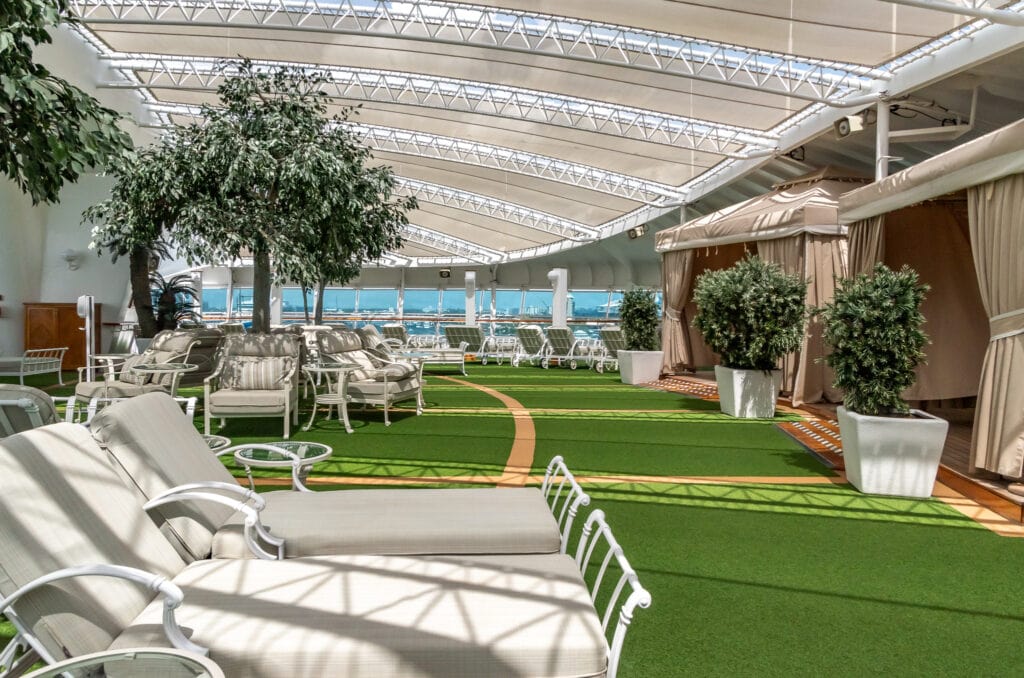
I had booked a lounge chair for the Panama Canal transit day in the adults only Sanctuary as soon as I boarded the ship on the first day. The reservation included breakfast, lunch and afternoon tea.
The Sanctuary was located at the very front of the ship on deck 17. This high up front and center vantage point gave great views of the locks and Gatun Lake but because of the protective colored glass above the railings, it was not good for photos. Still, for a few hours, it was nice to be free from the crowds on the decks below .
The cruise through Gatun Lake to the Pacific side locks took about 5 hours. During that time we passed a number of huge cargo vessels on their way to the Atlantic side locks.
We picked up two new tugboats and entered the first of the Pacific Cocli locks at about 2:30 in the afternoon. This time, a huge cargo container was also passing through the lock complexes ahead of us.
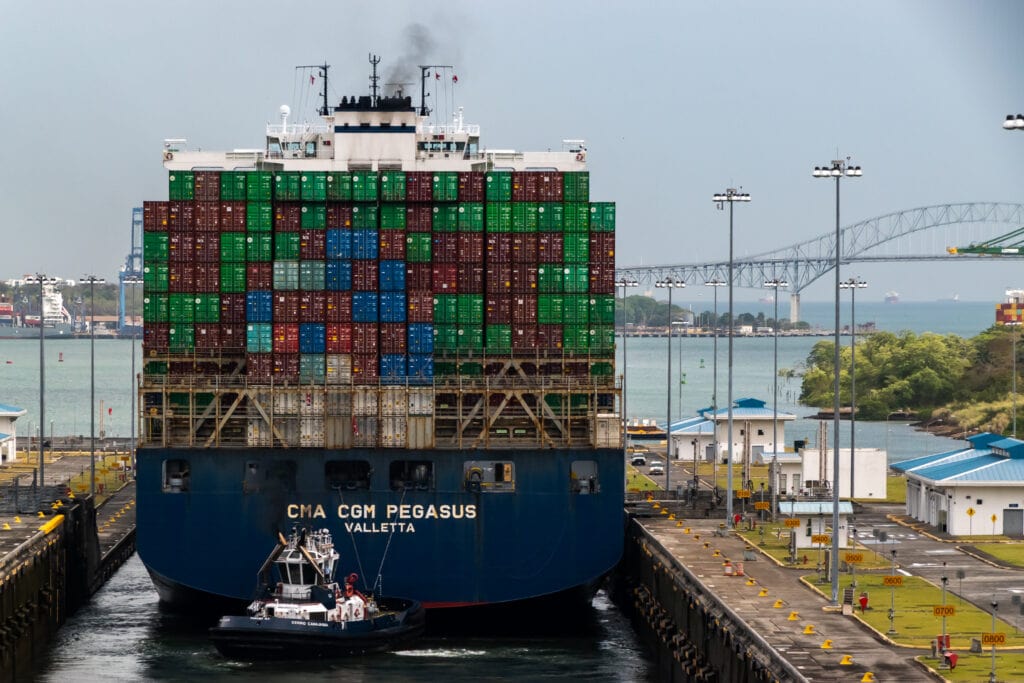
The process was the same as in the morning, but this time, we lost water in each lock as we dropped the requisite 27 feet in every lock.
Once we passed through the final lock, there was one more challenge ahead of us. The Bridge of the Americas is now the limiting factor on the size of the ship that can pass through the new Panama Canal. The Ruby Princess made it under the bridge with a whole foot to spare!
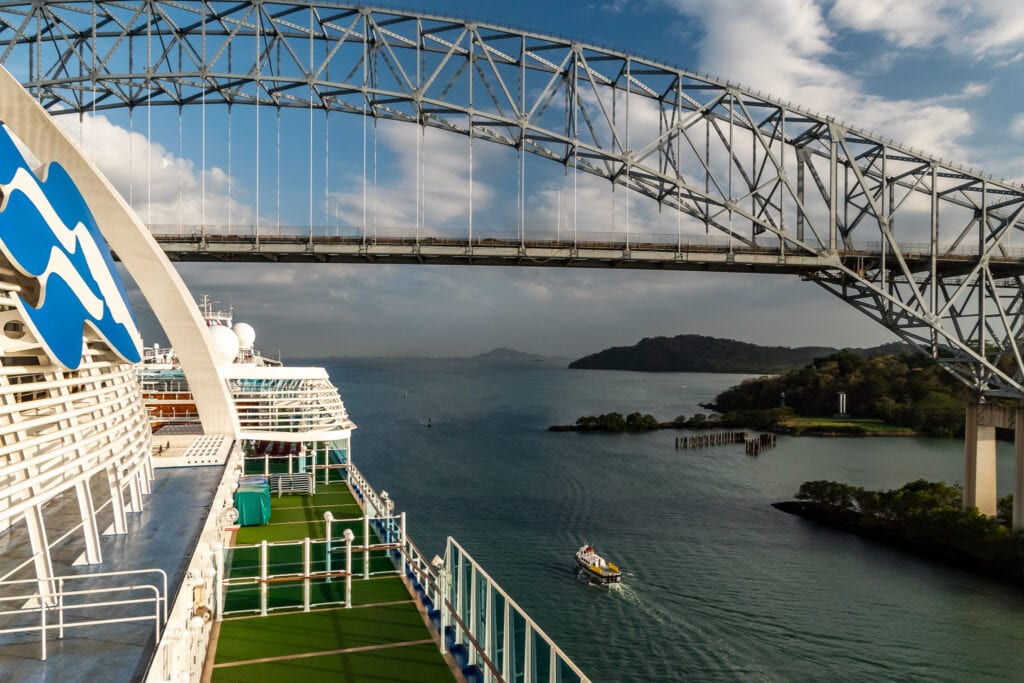
It took our ship the best part of a whole day to cross the Panama Canal from Colon city on the Atlantic side to Panama City on the Pacific side. At the end of the day, we docked at Fuerte Amador, the port gateway to Panama City, where we spent the next day on shore excursions exploring the region.
After that it was on to Costa Rica, Cabo San Lucas, and then on to the final port of San Francisco.
I specifically chose this cruise because it did a full transit through the Panama Canal and I was not disappointed. It truly was a unique experience that was a bucket list item for me. Not only did I learn a lot, but I really enjoyed seeing the whole transit process and would not hesitate to take this cruise again.
Travel tips for Panama Canal cruises
- Decide if you want to do a full transit or a partial transit through the Panama Canal.
- A partial transit is normally a shorter cruise and takes you through one set of locks and then eventually back to the starting port city.
- A full transit cruise takes two weeks or longer and travels through the whole canal from the Atlantic to the Pacific (or vice versa). It starts in one port city and ends in a different port city so you will need two one way airline tickets to get back home.
- If you want to spend the Panama Canal transit day in the Sanctuary, make sure to book it first thing once you are onboard.
- Your friends and family back home can see the views as you go through the Panama Canal via the Princess bridge web cams.
- The area around the Panama Canal is a rain forest, so expect warm, humid, and possibly rainy weather, especially if transiting during the rainy season months of April to December.
Hope this post helps you plan your Panama canal Cruise.
Links to all my cruising content, including all my other Princess cruises, can be found on my Experience – Cruising page.
Other related stories:
My Ruby Princess cruise review: Living Like Royalty on a Princess Cruise – A Ruby Princess Review With Photos
Sharing My Panama Canal shore excursion experiences: I Loved These Panama Canal Cruise Excursions
How I spent my day in Cartagena, Columbia: One Day in Cartagena, Columbia – A Colorful Independent Cruise Excursion
All about my local cooking class excursion in Costa Rica – A Costa Rican Cooking Class – Forging Local Connections on an Atypical Cruise Excursion
Please note that I received a media upgraded cabin from Princess. All content and opinions in this post are my own.
Thanks for visiting
Rose
Pin this!

